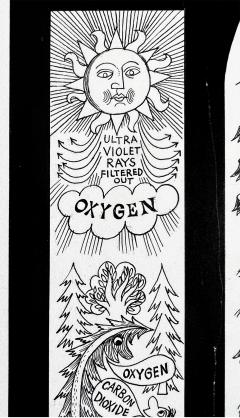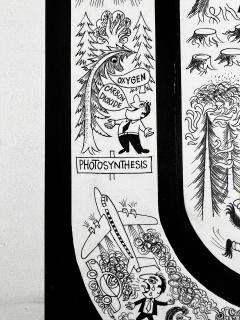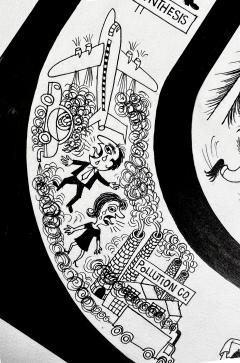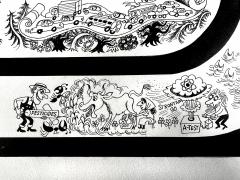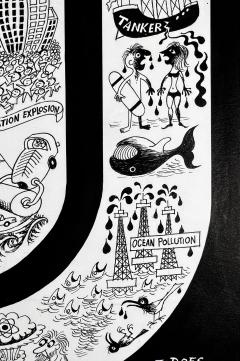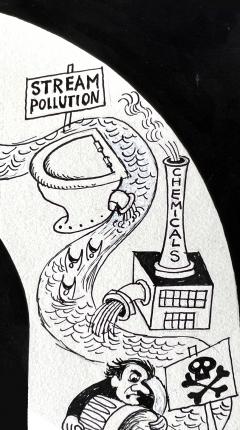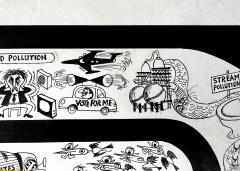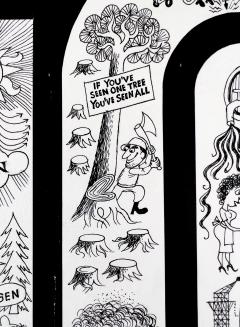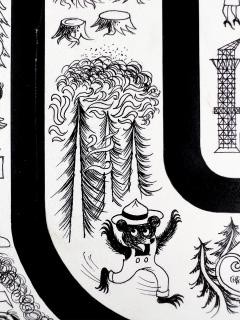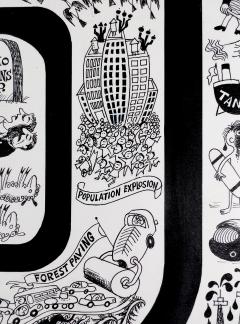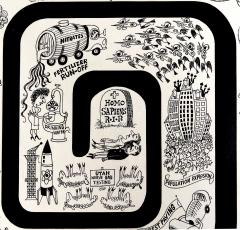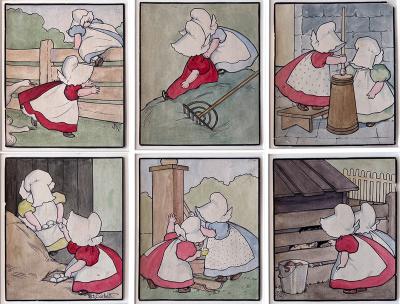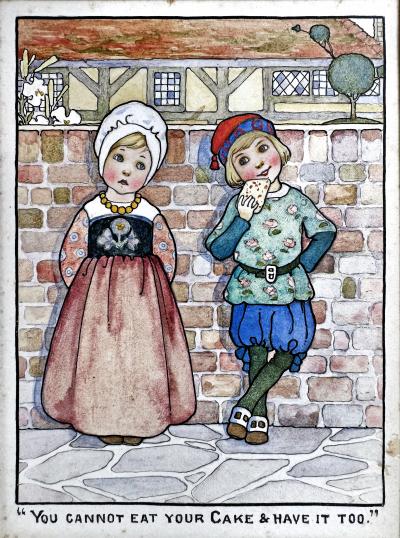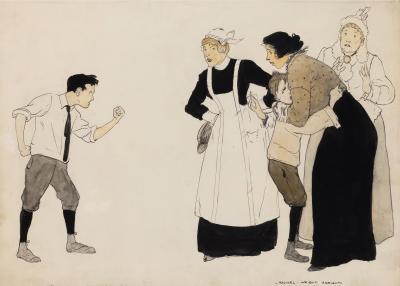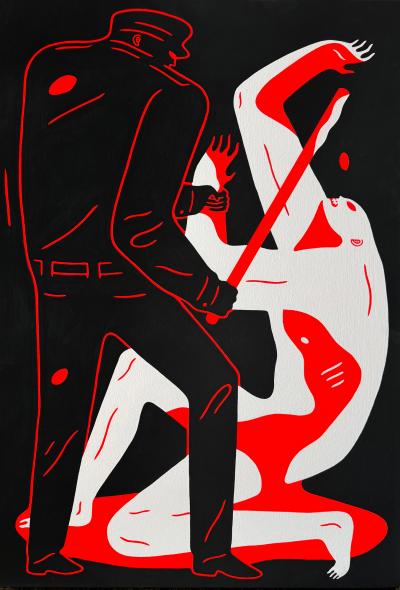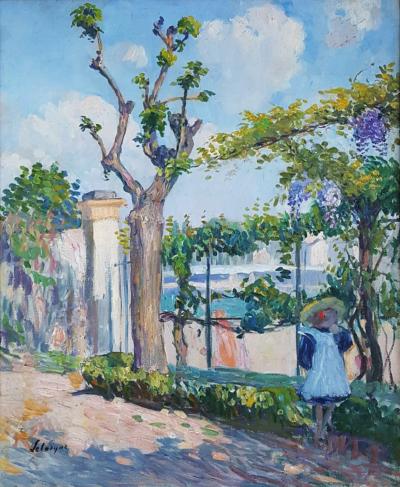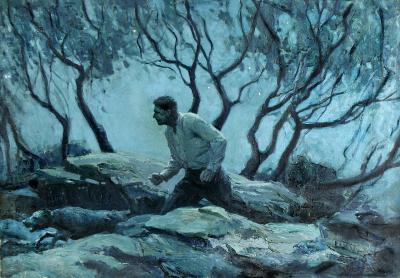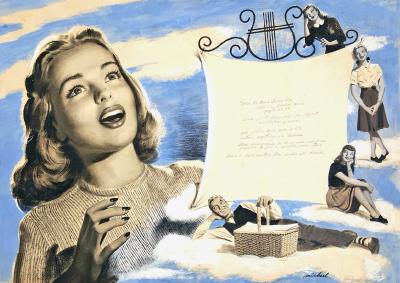Environmental Prognostication Coil Narrative "Homo Sapiens R.I.P
-
Description
"They paved paradise and put up a parking lot," Joni Mitchell said. - - Created in 1969, at the dawn of the American environmental movement, artist Richard Erdoes draws a sequential narrative in the form of a coil. From inception to destruction, , it illustrates a list of things that humans are doing to destroy the world we live in. The work was commissioned for school-age humans and executed in a whimsically comic way. Yet the underlying narrative is sophisticated and foreshadows a world that could be on the brink of ecological disaster.
Graphically and conceptually, this work exhibits an endless amount of creativity and Erdoes cartoony style is one to fall in love with.
Signed lower right. Unframed 12.4 inches Width: 12.85 inches Height is the live area. Board is 16x22 inches.
Richard Erdoes (Hungarian Erdős, German Erdös; July 7, 1912 – July 16, 2008) was an American artist, photographer, illustrator and author.
Early life
Erdoes was born in Frankfurt,to Maria Josefa Schrom on July 7, 1912. His father, Richárd Erdős Sr., was a Jewish Hungarian opera singer who had died a few weeks earlier in Budapest on June 9, 1912.After his birth, his mother lived with her sister, the Viennese actress Leopoldine ("Poldi") Sangora,He described himself as "equal parts Austrian, Hungarian and German, as well as equal parts Catholic, Protestant and Jew..."[4]
Career
He was a student at the Berlin Academy of Art in 1933, when Adolf Hitler came to power. He was involved in a small underground paper where he published anti-Hitler political cartoons which attracted the attention of the Nazi regime. He fled Germany with a price on his head. Back in Vienna, he continued his training at the Kunstgewerbeschule, now the University of Applied Arts, Vienna.[5] He also wrote and illustrated children's books and worked as a caricaturist for Tag and Stunde, anti-Nazi newspapers. After the Anschluss of Austria in 1938 he fled again, first to Paris, where he studied at the Academie de la Grande Chaumiere, and then London, England before journeying to the United States. He married his first wife, fellow artist Elsie Schulhof (d. xxxx) in London, shortly before their arrival in New York City.
In New York City, Erdoes enjoyed a long career as a commercial artist, and was known for his highly detailed, whimsical drawings. He created illustrations for such magazines as Stage, Fortune, Pageant, Gourmet, Harper's Bazaar, Sports Illustrated, The New York Times, Time, National Geographic and Life Magazine, where he met his second wife, Jean Sternbergh (d. 1995) who was an art director there. The couple married in 1951 and had three children.[6] Erdoes also illustrated many children's books.
An assignment for Life in 1967 took Erdoes to the Pine Ridge Indian Reservation for the first time, and marked the beginning of the work for which he would be best known. Erdoes was fascinated by Native American culture, outraged at the conditions on the reservation and deeply moved by the Civil Rights Movement that was raging at the time. He wrote histories, collections of Native American stories and myths, and wrote about such voices of the Native American Renaissance as Leonard and Mary Crow Dog and John Fire Lame Deer.[7] The Erdoes' New York City apartment was a well known hub of the American Indian Movement (AIM) in the early 1970sand he became involved in the legal defense of several AIM members.[citation needed] In 1975 the family moved to Santa Fe, New Mexico where Erdoes continued to write and remained active in the movement for Native American civil rights.
His papers are preserved at the Beinecke Rare Book and Manuscript Library at Yale University.[8]
Works
As author:
Peddlers and Vendors Around the World (1967)
Policemen Around the World (1967)
Musicians Around the World (1971)
The Sun Dance People: The Plains Indians, Their Past and Present (1972)
The Rain Dance People: The Pueblo Indians, Their Past and Present (1976)
The Woman Who Dared (1978)
Saloons of the Old West (1979)
The Native Americans: Navajos (1979)
Native Americans: The Sioux (1982)
Native Americans: The Pueblos (1983)
The Richard Erdoes Illustrated Treasury of Classic Unlaundered Limericks (1984) I
A.D. 1000: Living on the Brink of Apocalypse (1988)
Crying for a Dream: The World through Native American Eyes (1990)
Tales from the American Frontier (1992) ISSN 0362-8930
Legends and Tales of the American West (1998) I
As illustrator:
The Cat and The Devil (1964) by James Joyce
Come over to My House (1966) by Theo. LeSieg (pen name of Theo Geisel aka Dr. Seuss)[
The Spotted Stones (1978) by Silvio Bedini -
More Information
Documentation: Signed Origin: United States, New York Period: 1950-1979 Materials: Ink and gouache on illustration board Condition: Good. unframed. Good conditiion Creation Date: 1969 Styles / Movements: Modernism, Surrealism, Illustration Incollect Reference #: 701148
Message from Seller:
Robert Funk Fine Art in Miami offers an eclectic collection shaped by 45 years of experience, blending art with commercial perspectives. For inquiries or art advisory services, contact Robert Funk at decoypoet@yahoo.com or 305.857.0521.

















